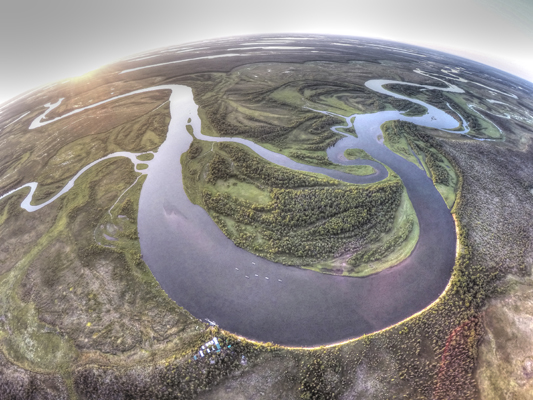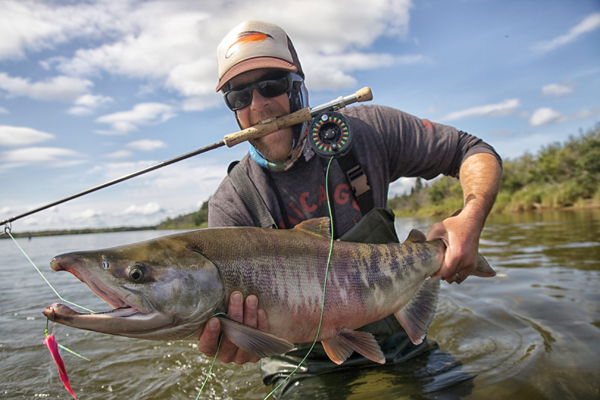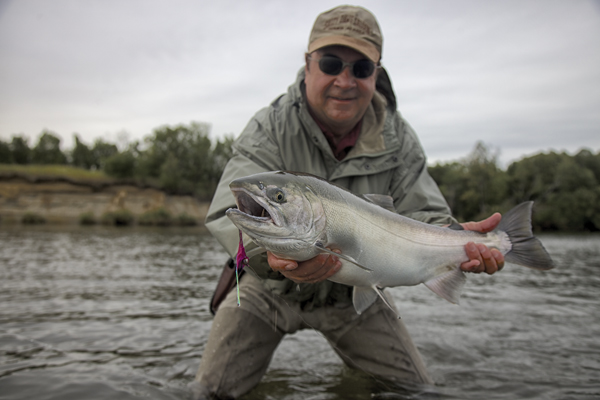Story by Cecilia “Pudge” Kleinkauf
Photos by John Landry
Alibis may be what criminals use to avoid the appearance of guilt, but they are also invented by all of us who just don’t want to be caught indulging ourselves when other duties call, like, for instance, when we are going fishing on a work day. But in spite of its name there’s a place on the world-famous Alagnak River where you won’t need an alibi, just a fly rod and a taste for prime angling.
I first visited the Alagnak River over 30 years ago when I was just learning to fish with a fly rod, and I jumped at the chance to go back this summer during silver season in August. It’s an amazing river, and I was delighted to find that I was going to be fishing the tidewater section, a part of the stream that I hadn’t visited on my earlier trip.
Angler’s Alibi is only accessed by floatplane, and things were pretty quiet when I arrived on the first morning of my trip. A few guests had returned for lunch and brought back their fish to be cleaned and put in the freezer. The camp staff got my bags into the comfortable weatherport tent (complete with carpeted wood floors, electricity and a heater) that was to be my home for the trip, and thankfully, there was a bug coil slowly burning so the mosquitoes weren’t too bad on this warm, calm day.

Guide John Landry, who had come back to camp to help me get geared up and ready to go, procured me a sandwich, put my gear in the boat and then pointed it downriver where a few other guests were fishing off of some of the incredible sandbars that extend far out into the river when the tide is low. I hopped out with my 8-weight and a hot pink fly called the Thermonator that had been created by guide-in-training Chris Emmens, who would be my guide for the remainder of my stay. He told me there was good fishing just a 10-minute boat ride away from the lodge in either direction, and he was right! The couple that I was to share a boat with that day were both hooked-up as I joined them.
I couldn’t believe that the entire bottom of the river in this area was not gravely, or rocky, or muddy, but completely sandy. It’s been a long time since I had such easy wading. I still relied on my trusty wading staff, however, because the movement of the water was creating ledges that weren’t always visible on the surface. We were only a few miles from the mouth of the Alagnak, and the tide from Bristol Bay changed the fishing spots regularly.
I’d only made a few casts before registering a good hit, when a fish grabbed the fly and headed off on a run that took it almost to the far side of the river. Because it didn’t jump, I could tell that it wasn’t a silver. Instead, it was a huge chum salmon, one of the many that were mixed with silvers in the large schools of fish that the incoming tide was pushing towards us.
I quickly got the hang of sighting the fish through the small waves that signaled their shadows against the shallow, sandy bottom. Unfortunately, I couldn’t always tell a chum from a silver so that I could target just the coho.
Because they were fresh from the bay, both species were absolutely in their prime. The chums were just barely striped-up, and the silvers were gray ghosts with a black tail. And they were everywhere! Swirling around, heading toward us, changing course at the last minute when they saw us, and even battling each other at times when they were thick. There were so many visible pods of fish that it was hard to pick one to cast to.
Most of the fish seemed to be chums, so we hopped in the boat and John delivered us to a beautiful bluff where lots of silvers had been caught that morning, but it really didn’t change our luck. Then, it was back to the lodge for a shower, some wine and a wonderful dinner of exceptional fish tacos, as well as a chance to meet the guides and some of the guests. Hardly any of them were on their first trip to the lodge.

All the meals take place in a large weatherport that holds the kitchen and is easily roomy enough for the 12 guests that the lodge hosts each week, with a lovely, new screen porch from which to see the dock, the boats and the evening sun setting on the river.
It was pitch black in my weatherport when I woke up early the next morning but I could easily hear the guides shuffling around, getting the boats ready for the day, sharing a cup of searingly-hot coffee, and discussing which boat was going to fish which area. Camp staff comes around each morning to turn on your heater and bring you coffee to jump-start the day. You can either wait for them or fumble around for your flashlight to get out of bed and get dressed. Breakfast is always hearty and filling for the day to come.
It doesn’t take long for everyone to get ready, and anticipation is high. Guests often fish with different guides on different days and depending on the tides, they head to ‘Wayne’s World,” “Shortcut,” or “Long,” the names of some of the sandbars where they can wade. If the tide is too high, then everyone drifts and fishes along the banks where the fish move in the quieter water while they wait for the tide to fall. Either way, everybody is usually limiting-
out quickly.
Chris and I headed downriver along with a second boat with Dirk and Lou, two fly anglers from Utah who were staying in the weatherport right next to mine, and we all stopped on the sandbar that I had fished the day before. Fish were absolutely everywhere and the three of us seemed to be hooked up all the time. We shortly gave up on trying to count how many chum salmon everyone caught because at times you couldn’t put your fly back in the water fast enough after releasing one.
It wasn’t too hard to tell when we had a silver instead of a chum, though, because they launched themselves out of the water to show-off a bit. Then it was an exhilarating and challenging struggle to get them back under control and ready for the net. One especially large buck spooled me four times before coming to the net. A large brown bear was watching us from the bushes nearby but decided not to come out and join the fun.
The third day I was lucky enough to be able to share a boat with one of the other guests and travel upriver to the famous Alagnak braids, where I had fished so many years ago. It was just barely lighting up on the river and mist still hung in the bushes as we took off. It was a definite treat to have John be our boat driver. I can’t remember ever seeing anyone navigate so well such complicated back sloughs and hidden little rivulets where salmon were spawning and the rainbows were feeding. I think he knew every leaf on every tree hanging out over the water, and we were soon at our destination—a small, “nothing-looking,” swampy area. My boat partner had hooked three nice rainbows before I could get out of the boat.
I soon caught up to him, though. We fished beads to imitate the salmon eggs and fish from 10- to 20-plus inches were plentiful. Mainly our success was with rainbows, until I found a pretty little drift just chocked full of grayling, my favorite fish. It was a one-right-after-the-other day and we took advantage of it. After lunch we produced similar results in another area where at least four different channels held fish; we moved from one to the other, scoring in all of them. During the day we saw a couple of rafts navigating the river and they apparently were having as good a day as we were. Other boat traffic on the river was virtually non-existent.
John also guides in Florida in the winter, as well as being the videographer for the lodge, thanks to his helpful GoPro camera and drone, so we entertained ourselves with some of his videos and still photography whenever we could. His video of the camp and the fishing experiences is astounding and definitely enriches the lodge’s website. You’ll gasp with disbelief at all the hundreds of fish you can see from the air! You definitely want to be in one of those boats charging down the river to intercept them all.
Many of the other guests had gone on a fly-out to Contact Creek while we went to the braids, and they bragged that they had seen almost as many bears as rainbows. They’d had an unexpected turn of events when a missed trail marker resulted in a longer hike than they had expected, but they reported the fishing was well
worth it.

The Alagnak is a 64-mile long tributary of the Kvichak River and the two join to flow into Bristol Bay. Also referred to as the “Branch River,” because of the vegetation and changing channels in the Braids, the name “Alagnak” translates to “making mistakes” or “confused river,” describing these travel conditions perfectly. The Alagnak River corridor has served as home to Yu’pik Eskimo people for thousands of years, and just as it does today, the river has always provided a significant portion of their subsistence lifestyle.
Angler’s Alibi has been in operation since 1994, after starting as an outpost camp and boat storage for a larger lodge. The owner then, Karl Storath, a New York restaurateur, set a standard of excellence that still prevails. Each guest still gets a chance to order a meal to their liking from the breakfast menu rather than having the common cafeteria-style meals often found in other lodges. Karl is also remembered as the lodge owner who strove to have his clients catch the most fish in the river, and who developed a fishing program to accomplish just that. In 1994 the lodge established a tradition of creating a picture book of clients with their fish, and it is really fun to sit and look at all the great catches by other guests over the years.
Current owner, John Perry, also a Colorado fishing guide, joined the lodge’s team as a guide in 1995 and in 2012 took over ownership of the lodge. Pledging to continue the exceptional service, he also promises to keep the fishing program as the lodge’s top priority. You can certainly see that he and his staff of ten (six exceptional guides and four camp helpers) work hard to keep that promise, and their success is reflected by their 80% return rate.
Lodge food is always one of the important parts of any fishing trip, and Chef Ben, a master at his craft, left us drooling each day with anticipation for what the evening meal would bring. Then, believe it or not, the lodge staff stands ready to take guests out after dinner each evening to fish some more until the 10 o’clock curfew when the generator goes off, and many take advantage of
the opportunity.
I especially liked the fact that the lodge has a soup and sandwich meal in the dining room at lunchtime on cold, wet days. It gives guests a chance to rest or bring fish back to be vacuum-sealed and frozen. Chris and I took advantage of the lunch soup after a morning of spectacular silver fishing on my last day at the lodge after the tide provided us with an absolutely overwhelming number of fish. All by ourselves, the bright, aggressive silvers surrounded us, almost begging to be the next one caught. At times the swirls and wakes were almost bank to bank and fish even bumped into our legs a time or two. Heading back to the lodge meant heading home for me so it was a rather bittersweet lunch. But when my waders, boots and rod were all packed I was ready to go.
Naturally, I hated to have to leave. However, I’ll keep thinking of all those sockeye and all those kings that crowd the river earlier in the summer, just like the silvers that do in the fall. I should have enough fish dreams to keep me happy—at least for a while.
Cecilia “Pudge” Kleinkauf has owned and operated Women’s Flyfishing, a Trout Unlimited-endorsed business, for 28 of the 44 years she has lived and fished in Alaska. She teaches women how to fish with a fly rod and guides women and couples to various locations in Alaska throughout the summer. Besides being a contributing editor for Fish Alaska magazine, Pudge is the author of four books, the most recent of which is Pacific Salmon Flies: New Ties & Old Standbys. She can be reached at
www.womensflyfishing.net.
IF YOU GO:
Angler’s Alibi
John Perry
www.AnglersAlibi.com
1 River Front Road
King Salmon, AK 99613
(561) 222-9416
john@anglersalibi.com
The Happy Meal

This fly was created by guide Chris Emmens (chrisemmens@gmail.com) and is a proven producer on the Alagnak. Give it a try there, or on your local water, and get ready for some steady salmon action
Materials:
• 1 ½-inch Blane Chocklett’s Articulated
Big Game Shank (stainless steel)
• Senyo’s Standard Intruder Trailer Hook
Wire for size 6 or larger (FL. pink)
• FL. Pink Ultra Thread 140
• EP Anadromous Brush (FL. Pink)
• Hareline Dubbin X- Select Marabou
(Hot Pink)
• Hareline Dubbin Marabou Strung
Blood Quills (Fl. Cerise)
• Lead Eyes Original Dumbbell Eyes
Plain, Med (1/30 oz)
• Size 2 Gamakatsu octopus hook
• Flashabou (silver)
Tying Recipe
1. Wrap shank in a layer of thread and then proceed to lash on the lead eyes.
2. Cut a piece of wire to desired length (leave a loop hanging off the back of the shank, just big enough to girth-hitch a size 2 Gamakatsu octopus hook).
3. Heavily wrap thread over the two strands of wire up the shank of the hook.
4. Double back the wire and heavily
wrap over it (this will secure the wire so it doesn’t slip).
5. Make two wraps of EP Anadromous Brush on the very back of the shank.
6. Then put a few strands of Flashabou on the top and bottom of the brush.
7. Wrap the hot pink marabou to desired fullness.
8. Add two more wraps of EP Anadromous Brush.
9. Wrap fluorescent cerise marabou to desired fullness and add one more layer of EP Anadromous Brush.
10. Disperse an even layer of Flashabou and whip-finish the fly.
